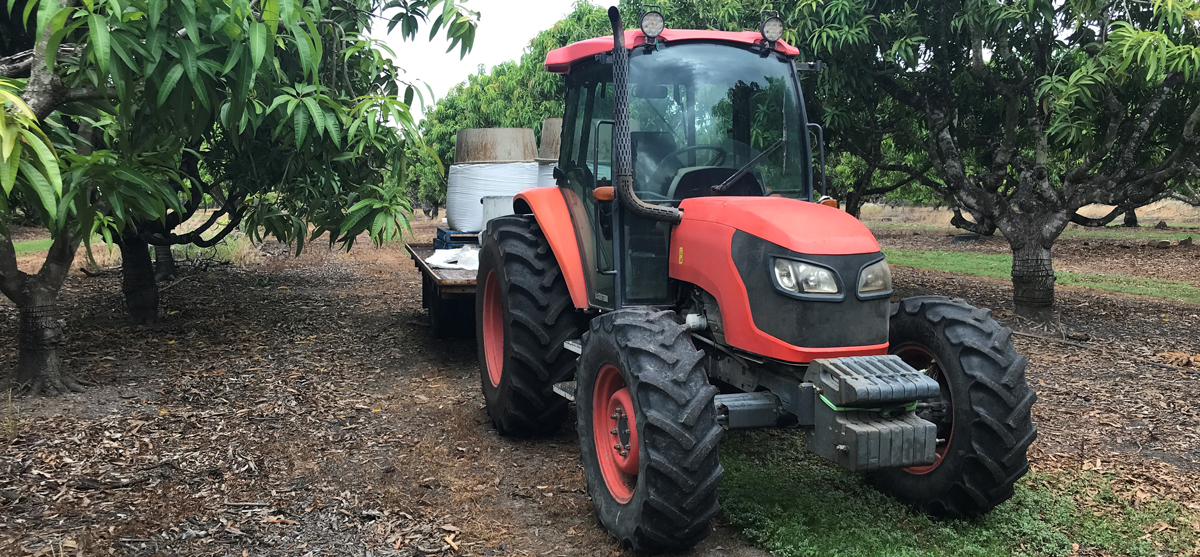Risk of lightning strikes to outdoor workers
The purpose of this Safety Alert is to remind businesses and workers of the inherent dangers of lightning strike in the Top End, and the need to manage the risk of serious injury or death to outdoor workers. This information is especially relevant to workplaces located in the Top End due to the frequency of thunder storms from the months of November to April.
Background
During the afternoon of Tuesday 23 November 2021, three workers working on a mango farm were injured (one critically) when lightning struck a nearby mango tree.
At the time of the incident, the three workers were fertilising trees while standing on a metal flatbed trailer being towed by a tractor through the mango orchard. The three workers were transported to Royal Darwin Hospital, where unfortunately one of the workers succumbed to his injuries later in the week.
Preliminary findings indicate that during an approximate one hour period that afternoon, 38 lightning strikes were recorded within a 50km area of the incident scene.

Possible contributing factors
- The workers were working outside amongst an orchard of trees.
- The workers were standing on a metal flatbed trailer.
Action required
Businesses and workers operating outdoors, especially those in the Top End, must have procedures in place to manage the risks associated with lightning strikes.
The procedures should include:
- Monitoring weather forecasts and conditions to determine the possibility of a thunderstorm forming or if there is an approaching thunderstorm.
- An established method of warning supervisors and workers working outdoors of an approaching thunderstorm.
- An established set of actions workers should take if they see lightning or hear thunder before a warning is received.
- Specified, documented and communicated (to workers) procedures of when to stop outdoor work and seek shelter, including the timeframe workers have to reach shelter; and when it is safe to resume outdoor work.
- Identify locations to safely shelter within close proximity of the worksite. Safe shelters include:
- Fully enclosed large permanent structures or substantial buildings; or
- Enclosed 'hard-top' (metal-bodied) vehicles.
- Checking in with all your workers after the thunderstorm has passed.
Actions workers should take include:
- Alerting your supervisor or fellow workers if you see lightning or hear thunder and seek shelter according to your established procedures.
- Never seek shelter in temporary structures, sheds, buildings with unearthed metal roofs, or under trees.
- Avoid bodies of water and metal objects such as fencing that may conduct electricity.
- When sheltering (including inside a vehicle), avoid contact with the external surfaces, metal objects such as pipes, wiring, metal parts of the vehicle, and avoid using plugged in electrical equipment.
- Workers who are caught away from shelter should:
- Avoid being on the highest point in an open area or near tall objects, but do not lie flat on the ground.
- Crouch (alone) with your feet together, preferably in a ditch or hollow so you are not the highest object.
- Remove all metal objects from your body.
Further information
For further information, please refer to the following:
- Preparation and safety during thunderstorms (Bureau of Meteorology)
- Average annual thunder-day and lightning flash density (Bureau of Meteorology)
- Lightning and outdoor work (Department of Mines, Industry Regulation and Safety WA)
Safety Alerts
- Lightning strikes on rubber-tyred vehicles (Resources Health and Safety Queensland)
Disclaimer
This Safety Alert contains safety information following inquires made by NT WorkSafe about an incident or unsafe practice. The information contained in this Alert does not necessarily include the outcome of NT WorkSafe’s action with respect to an incident. NT WorkSafe does not warrant the information in this Alert is complete or up-to-date and does not accept any liability for the information in this report or as to its use.